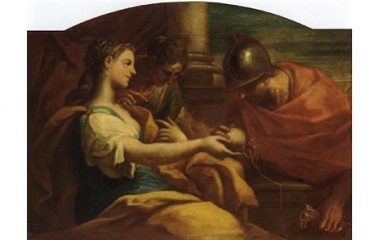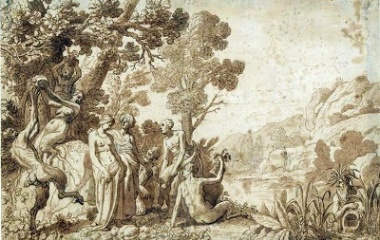Who is Ariadne?
Though many different tales exist about the Greek goddess, Ariadne, it is commonly posited that she led a life of much suffering, especially after leaving Crete. While in Crete, she was venerated as a vegetation goddess and later developed a cult following, especially on the Greek islands. Though the goddess is most commonly known for her involvement in the killing of the Minotaur in the Labyrinth in Crete, she was also the owner of the first ever dance floor, created by the brilliant inventor, Daedalus.
Legends and Stories
Androgeus, the son of Minos, participated in the Panathenaic games, held in Athens every four years. His exemplary skill, however, caused grave jealousy among the Athenians, who decided the best solution was to have him killed. In another version of this legend, the King of Athens sent him to kill the Marathonian Bull, an allegedly unconquerable beast. On hearing of his son’s death, Minos, the King of Crete, exacted revenge on Athens and decided to declare war on the city. The Athenians, not wanting to engage in brutal warfare, requested terms of surrender from Minos instead. Minos agreed to their surrender, but made sure those responsible for his son’s death paid dearly. He demanded a sacrifice of 7 maidens and 7 young men to the beast, the Minotaur, half man and half bull. Every year the sacrificial Athenian youth were sent into the Labyrinth in Crete where the beast dwelled. Since the Labyrinth was constructed by the genius inventor, Daedalus, it was thought impossible for anyone to emerge from its many twists and turns, before being annihilated by the Minotaur.
Theseus and Dionysus
Only with Daedalus’ help could Ariadne devise a plan to aid one man out of the Labyrinth. The man she chose to aid was an Athenian by the name of Theseus, with whom she had fallen in love. In return for her help, she asked him to wed her and take her to Athens. Ariadne provided Theseus with a ball of thread and a sword for his quest. Theseus used the thread to tie to the door at the maze’s entrance. This allowed him to find his way out of the Labyrinth again, after besting the Minotaur. He was able to kill the Minotaur and, after killing the beast, he escaped the intricate maze. He and the other sacrificial youth fled from Crete with Ariadne and arrived at the island of Naxos. Here, according to one version of the tale, Theseus left Ariadne on the island, perhaps because of her betrayal of her own country, which was viewed as a deplorable act at the time.
Her Death
A further version of the legend posits that, on being deserted on the island by Theseus, Ariadne hung herself from a tree. The goddess may also have died in childbirth in Cyprus after she and Theseus were married. The couple had been engaging in protracted celebrations in Crete and, after departing, had been caught in a storm at sea. Theseus managed to deposit her safely on the shore at Cyprus, but he was then washed out to sea. Ariadne was heavily pregnant and taken into the care of the Cyprian women. Later she died in childbirth and had a shrine dedicated to her.
Another version of the tale tells of Theseus abandoning the sleeping Ariadne on the island of Dia. Here she was possibly killed by Artemis, per Dionysus’ instructions or married Dionysus and was turned into an immortal by Zeus. Dionysus gave a crown to his unhappy consort to cheer her up and later turned the crown into the constellation, Corona.
Family
Ariadne had several children with Dionysus, including Staphylus, Oenopion, Thoas, Euanthes, and Maron.
Worship
The cult dedicated to the goddess spread from Crete to Argos, Naxos, Cyprus, and the other Greek islands. Followers performed ceremonial dancing, participated in orgies and sometimes even included a ceremony where a young man emulated the pains and screams of a woman going through childbirth.
Modern Influence
Richard Strauss wrote an opera called Ariadne auf Naxos, Ariadne on Naxos, which was first performed in 1912.










